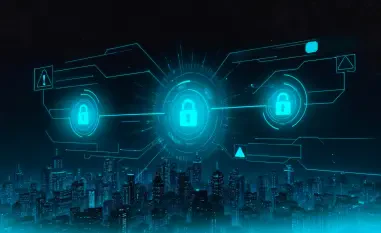Listen to the Article
Why Europe’s sweeping cyber regulation is about to reshape how B2B enterprises manage third-party risk, resilience, and trust.
Cyber threats are no longer isolated incidents, from ransomware attacks on logistics firms to vulnerabilities in widely used software; they are proving to be systemic risks. In 2025, the stakes are higher than ever. As the supply chain increasingly goes digital, the ripple impact of a single attack can make entire industries come to a screeching halt.
European organizations face a growing risk of cyber incidents due to the increased sophistication of attack approaches, increased digital service dependency, geopolitical tensions, and new technology like Generative AI.
In this context, the regulatory landscape is also evolving, forcing organizations to keep pace with growing demands. As good-intentioned and necessary as it may be, and while it’s aimed at providing a framework of protection, the compliance treadmill can be exhausting for many.
Enter the NIS2 Directive.
This European Union regulation expands the rules for cybersecurity and reframes the conversation entirely. For the first time, supply chain integrity is being treated as a shared, cross-border responsibility, and its impact isn’t limited to Europe alone. This article will explore what the NIS2 Directive is, why it matters to businesses beyond Europe, and how your company can align its global supply chains to meet its elevated security standards.
The Evolution From Nis to Nis2
Directive 2022/2555, commonly referred to as the Network and Information Systems Directive (NIS), was adopted on July 6, 2016. It was the EU’s first legislation aimed at improving cybersecurity across member states. However, it proved inconsistent in implementation, with gaps in enforcement and divergent standards between countries. The European Commission, therefore, revamped the law to generate the Network and Information Security Directive 2, implemented in January 2023, and significantly increased the standards.
The new directive broadens the scope of sectors and categories of entities covered—from energy and transport to digital infrastructure, agriculture, and even waste. It imposes stricter risk management requirements, which compel enterprises to inform their security incident response teams of critical cybersecurity incidents within 24 hours of being notified.
Where global businesses are concerned, NIS2 is not merely an issue of the EU. Any company that operates in or partners with entities in the EU can indirectly fall under the directive’s scope and thus be required to comply.
A Supply Chain Wake-up Call
One of the most notable shifts in NIS2 is its new focus on securing the entire digital supply chain. Where previous regulations tended to hone in on an organization’s internal systems, the NIS2 requires businesses to assess and manage the risks posed by their suppliers, contractors, and digital service providers.
In practical terms, this means multinational enterprises must now conduct due diligence on the cybersecurity position of supply chain partners. Meaning vendor audits, common security procedures, and contractual terms regarding data protection and incident response are no longer best practices but regulatory norms.
In sectors where third-party software, cloud platforms, and application programming interfaces form the backbone of operations, one weak link can create cascading vulnerabilities that impact hundreds of businesses. NIS2 aims to address this exact risk.
Why Your B2b Enterprise Can’t Afford to Wait
For B2B leaders, the implications are clear: Compliance with NIS2 is not a box-ticking exercise but a competitive differentiator. Companies that demonstrate strong cyber hygiene and resilient supply chain security will gain a trust advantage with partners, clients, and regulators alike.
Moreover, failing to comply comes with consequences. Under NIS2, fines can reach up to €10 million or 2% of global annual turnover. Fines depend on an organization’s classification and the severity of the breach. Apart from economic expenses, loss of reputation and business disruption may be far costlier. The actual cost of non-compliance with NIS2 can be devastating, reaching beyond the bottom line to business continuity and trust.
The directive also places heavy responsibility on higher management. Boards and senior executives must be involved in cybersecurity governance, be continuously trained, and foster a culture of accountability throughout the organization.
Key Action Points for Aligning With Nis2
To attain NIS2 compliance and protect the global supply chain, this is what is required of your firm ought to:
Map your digital supply chain: Identify critical suppliers, digital service providers, and third-party dependencies worldwide.
Conduct risk assessments: Audit supplier cybersecurity controls and determine exposure to shared vulnerabilities.
Update contracts and service level agreements: Ensure that data security, breach notification, and risk mitigation responsibilities are clearly defined.
Implement continuous monitoring: Leverage tools that provide real-time visibility into third-party risk and incident response capabilities.
Train executives and staff: Foster a culture of cybersecurity awareness across all organizational levels.
These steps reflect a broader trend toward integrated, proactive security controls that protect business continuity and brand reputation.
Looking Beyond Compliance: Strategic Advantages
While the NIS2 imposes a minimum standard, progressive firms can use it as a spur to broader digital innovation. Investing in secure-by-design infrastructure, building trusted vendor relationships, and using automation for threat detection enables your firm to capitalize on regulatory leverage in terms of enhanced performance.
In addition, open compliance with NIS2 can be a significant selling point in B2B deals as more customers now expect their vendors to place high value on cybersecurity. Certification or self-assertion of conformity to NIS2-based standards will readily become a condition in high-value contracts.
Finally, NIS2 is an eye-opener for business leaders to bring cybersecurity out of the back office and into the center of corporate strategy.
Conclusion: Preparing for a More Secure Future
The NIS2 Directive is a defining moment for supply chain security in the digital age. With its expansive scope, tough penalties, and emphasis on third-party risk, the directive challenges businesses to rethink how they build and protect interconnected operations.
But more than a regulatory hurdle, NIS2 represents an opportunity to realign how businesses think about trust, resilience, and long-term value creation. As a leader, this shift demands a strategic mindset that sees security as a core driver of business continuity, stakeholder confidence, and market differentiation. Future-ready enterprises will embed security into procurement decisions, treat vendor risk as business risk, and proactively evolve with the threat landscape rather than react to it.
Are you ready?





